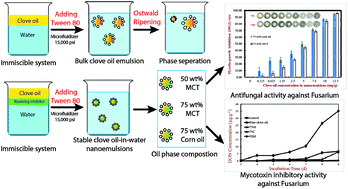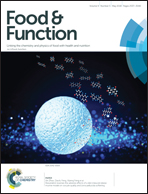Influence of oil phase composition on the antifungal and mycotoxin inhibitory activity of clove oil nanoemulsions
Abstract
The influence of oil composition on the physical properties and antifungal and mycotoxin inhibitory activity of clove oil-in-water nanoemulsions was investigated. Physically stable clove oil-in-water nanoemulsions could be fabricated by incorporating either ≥75 wt% of corn oil or ≥50 wt% of medium chain triacylglycerol (MCT) into clove oil before homogenization to prevent Ostwald ripening. The clove oil-in-water nanoemulsions with mean diameters of <150 nm showed high physical stability over 30 days storage. The antifungal activity of physically stable clove oil nanoemulsions was further evaluated using effective concentration (EC) and inhibitory activity towards mycotoxin production in two chemotypes of Fusarium graminearum isolates. The composition of the oil phase, i.e., ripening inhibitor type and concentration, in clove oil-in-water nanoemulsions had a remarkable impact on antifungal activity as well as inhibition of mycotoxin production. In general, under the same clove oil concentration in oil phase, the addition of MCT decreased the antifungal and mycotoxin inhibitory activity of clove oil more than corn oil. Compared with the bulk clove oil, this study also indicated that the mycotoxin inhibitory activity of clove was significantly enhanced when encapsulated in nanoemulsions. These results have important implications for the design of essential oil based nanoemulsions as effective antifungal and detoxification delivery systems in the food or other industries.



 Please wait while we load your content...
Please wait while we load your content...